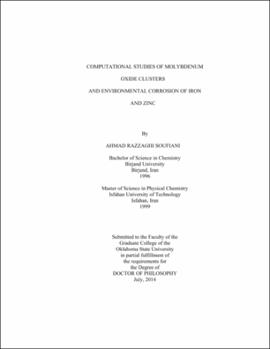| dc.contributor.advisor | Materer, Nicholas | |
| dc.contributor.author | Soufiani, Ahmad Razzaghi | |
| dc.date.accessioned | 2015-06-17T20:07:38Z | |
| dc.date.available | 2015-06-17T20:07:38Z | |
| dc.date.issued | 2014-07 | |
| dc.identifier.uri | https://hdl.handle.net/11244/15083 | |
| dc.description.abstract | This dissertation describes two creative activities. The first is a computational study of molybdenum oxide clusters and the other is an experimental study of the corrosion of metals. The first effort covers three topics. First, the UV-Vis spectra for molybdenum oxide clusters were simulated utilizing Time-Dependent Density-Functional Theory (TD-DFT) calculations. The effects on the spectra due to changes in the cluster size and the variation of the formal charge of the molybdenum were investigated. Specifically, the location and transition intensity of a charge transfer transition between the molybdenum atoms were identified. | |
| dc.description.abstract | The second computational topic explored the adsorption and dissociation of dimethyl peroxide on the (100) surface of molybdenum trioxide and the hydrogen molybdenum bronze using Density-Functional Theory (DFT) calculations. It was found that dimethyl peroxide adsorbs molecularly on the oxide and bronze surfaces. However, the decomposition can occur only on the bronze surface through an O-O bond cleavage pathway. The final computational topic examined the equilibrium between a molybdenum monomer and a mixed valence dimer complex with gluconic acid. UV-Vis spectroscopy was used to measure the concentration of the dimer and monomer as a function of time and temperature. For this data, the activation energy for the dimer dissociation and the Gibbs free energy of the equilibrium could be calculated. To complement the experimental results, the UV-Vis spectra for complexes were simulated using TD-DFT calculations. The results are in agreement with the experimental assumption that the equilibrium is between a mixed valence dimer and two monomers. | |
| dc.description.abstract | The second effort is the experimental study of metal corrosion using a new method for corrosion evaluation based on thin wires. This effort covers two topics. The first topic was the corrosion of small iron wires in sodium chloride solutions, which may lead to a rapid technique to measure the efficiency of corrosion inhibitors. The second topic was the corrosion of mild steel and the galvanic corrosion of zinc wires in two types of soils. These results were used to develop a wireless corrosion sensor for underground structures. | |
| dc.format | application/pdf | |
| dc.language | en_US | |
| dc.rights | Copyright is held by the author who has granted the Oklahoma State University Library the non-exclusive right to share this material in its institutional repository. Contact Digital Library Services at lib-dls@okstate.edu or 405-744-9161 for the permission policy on the use, reproduction or distribution of this material. | |
| dc.title | Computational studies of molybdenum oxide clusters and environmental corrosion of iron and zinc | |
| dc.contributor.committeeMember | Apblett, Allen | |
| dc.contributor.committeeMember | Lavine, Barry | |
| dc.contributor.committeeMember | Weinert, Charles Scott | |
| dc.contributor.committeeMember | Mintmire, John | |
| osu.filename | Soufiani_okstate_0664D_13503.pdf | |
| osu.accesstype | Open Access | |
| dc.type.genre | Dissertation | |
| dc.type.material | Text | |
| dc.subject.keywords | corrosion | |
| dc.subject.keywords | density functional theory | |
| dc.subject.keywords | iron and zinc | |
| dc.subject.keywords | molybdenum oxide | |
| dc.subject.keywords | sensor | |
| dc.subject.keywords | td-dft | |
| thesis.degree.discipline | Chemistry | |
| thesis.degree.grantor | Oklahoma State University | |
